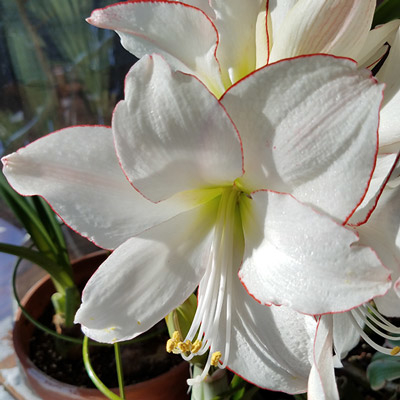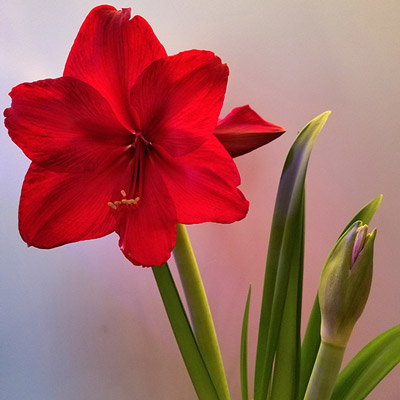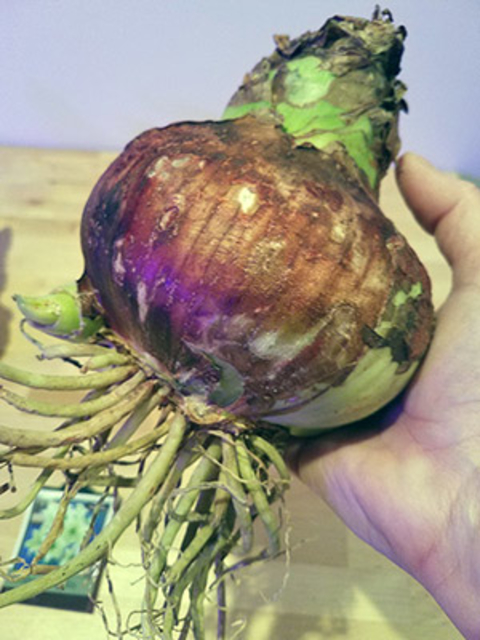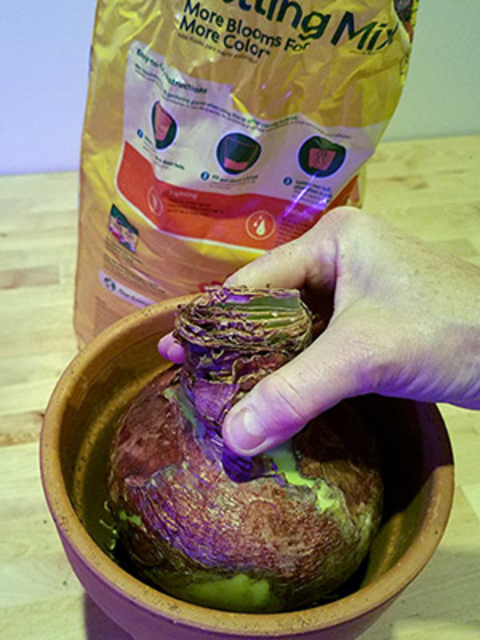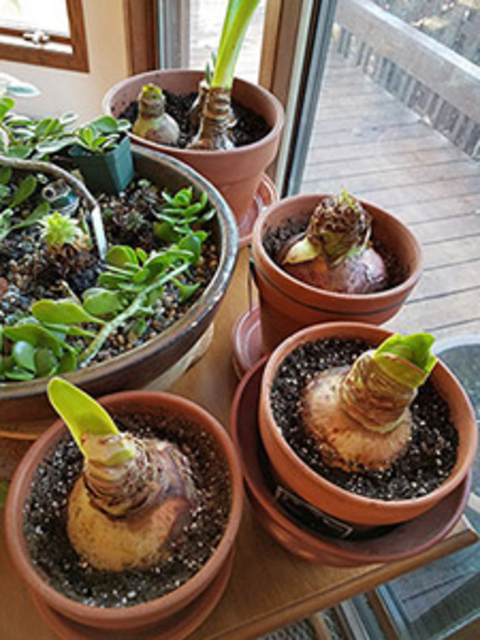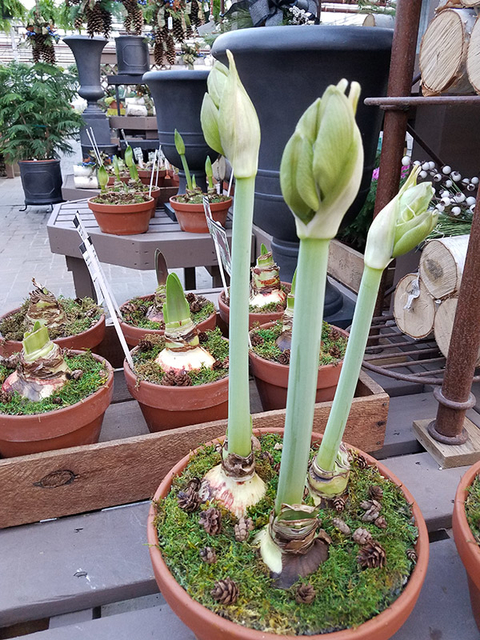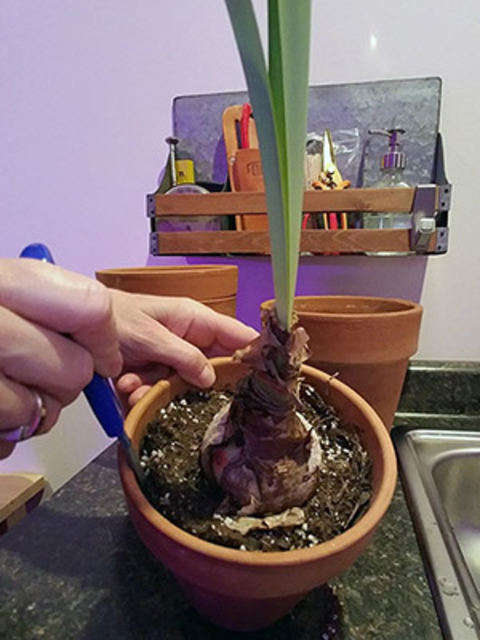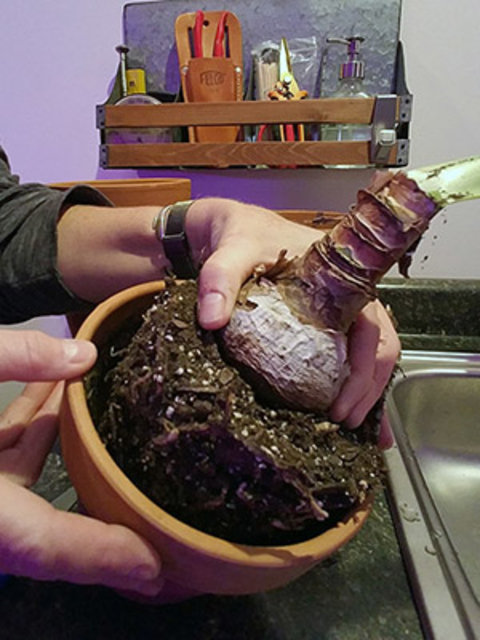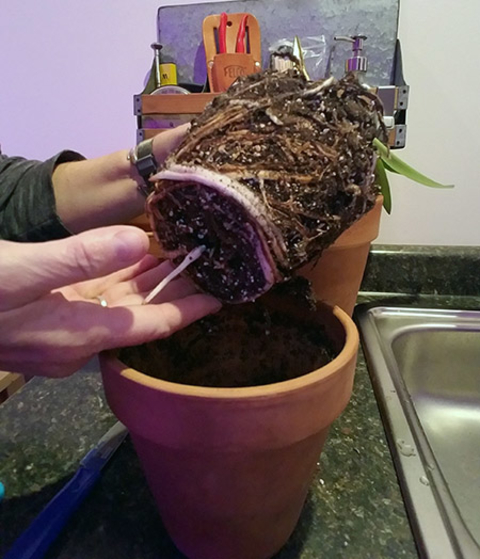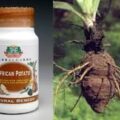Whether the first bulb or the fiftieth, there is high anticipation for the plant owner when the large, bright green bud emerges from a beefy amaryllis bulb!
Amaryllis may be purchased as bare or planted bulbs, and are prized for their exotic trumpet-shaped flowers born on 1- to 2-foot leafless stalks or scapes. They add dramatic color to homes and gardens and make wonderful gifts to gardeners from beginners to experts.
Native to Africa, the genus Amaryllis comes from the Greek word amarysso, which means “to sparkle.” Bulbs were brought to Europe in the 1700s and have been known to bloom for up to 75 years. However, the amaryllis bulbs we commonly purchase and grow as houseplants are hybrids of the genus Hippeastrum and are native to Central and South America.
Amaryllis flowers range from 4 to 10 inches in size and can be either single or double in form.
While the most popular colors are red and white, flowers may also be pink, salmon, apricot, rose or deep burgundy. Some varieties are bicolor such as purple and green, or picotee (having petals with a different edge color).
Selecting, planting and caring for bulbs
Amaryllis bulbs come in various sizes. Whether purchasing a bare bulb to plant or bulbs planted in a pot, the size and condition of bulbs will influence amaryllis performance.
- Select the largest bulbs available for the desired plant variety as they will produce more stalks and blooms in the first year. The larger the bulb, the more flowers it will have.
- Bulbs should be firm and dry with no signs of mold, decay or injury.
- It is common to see new growth (leaves, buds) emerging from bare or planted bulbs.
- Choose bulbs with bright green new growth and without spots or visible damage.
- Some bulbs may have an offshoot growing from its base. This will eventually grow into a new bulb and can be removed and planted separately.
Amaryllis grow best in narrow containers. Containers may be made of plastic, metal, ceramic or terracotta.
- Bulbs should be firm and dry with no signs of mold, decay or injury.
- Select a container that has one or more holes in the bottom and drains easily.
- Good drainage will minimize the chance of bulb or root rot (rotting from excess moisture).
- The diameter of the pot should be about 1 inch wider than the widest part of the bulb and twice as tall as the bulb to allow space for good root development.
- Fill the pot about half full with sterile, new potting soil high in organic matter such as peat moss.
- Set the bulb in the pot so the roots rest on the potting soil.
- The bulb should sit up above the edge of the container.
- Add more soil, tapping it down around the bulb, until one-third to one-half of the bulb remains visible.
- Firm the potting medium around the bulb.
- Set the pot in a sink where it can drain freely and water until the potting soil is thoroughly moist. Allow to drain completely.
- Set the pot on a saucer and place in a sunny window.
- Water the plant when the top 2 inches of soil feels dry, allowing the container to drain freely each time.
- Do not let the plant sit in water as wet soil can promote bulb and root rot and attract pests.
- Fertilize amaryllis each time you water at half the recommended strength when new growth is visible (including on newly purchased bulbs).
- To promote blooming, use a houseplant fertilizer with a high phosphorus content.
- Fertilizer packaging always provides an analysis shown in three numbers such as 10-20-15.
- These numbers represent the percentage of each of three important macronutrients for plant growth: N (nitrogen) – P (phosphorous) – K (potassium).
- In this example, the fertilizer contains 10 percent nitrogen, 20 percent phosphorous, and 15 percent potassium.
- Move the plant out of direct sunlight when the flower buds have begun to open.
The secret to keeping amaryllis thriving for years is to keep the plants actively growing AFTER they have finished blooming.
- After the flowers have faded, cut them off to prevent seed formation. Seed formation will deplete important energy reserves in the bulb and reduce blooming.
- Do not remove the flower stalk until it has turned yellow.
- A green stem will continue to promote photosynthesis, which creates energy that is stored in the bulb for future leaf growth and flowers.
- If the bulb does not produce a flowering stalk in the next blooming period, it is likely that has not stored enough nutrients during the post-blooming period.
- Keeping the plant healthy and growing will promote blooming.
- After your plant has finished blooming, place it in the sunniest possible location indoors. It will continue to grow long, smooth leaves. These leaves will promote photosynthesis.
- Continue to water and fertilize the plant regularly with an all-purpose houseplant plant fertilizer.
Keeping the plant healthy and growing throughout the summer will promote blooming later in the season.
- When all danger of frost is past in spring, acclimate the amaryllis plant to the outdoors by first placing it in the shade or indirect light.
- Gradually move the container to a location or garden bed where it will receive full sun for at least 6 hours daily.
- Select a sunny location on a deck or patio for your potted amaryllis, or just sink the entire pot into the soil in a sunny garden bed.
- It is not necessary to remove the amaryllis from the pot.
- Continue to fertilize monthly with an all-purpose houseplant or indoor plant fertilizer. This will help build up nutrients in the bulb for flower production the next year.
- Amaryllis plants should be brought indoors before the first frost in the fall.
- They will not survive frost or freezing temperatures.
Unlike some other bulbs, amaryllis do not require a rest or dormant period. They will bloom again if allowed to continue to grow.
But bloom time can be controlled by allowing the bulb go dormant (stop growing) for a period of time. During this resting period (dormancy), plants use very little of their energy reserves.
- After bringing the potted amaryllis indoors, store the potted plant in a cool, dry, dark location such as a basement or closet.
- The temperature should be around 50-60 degrees.
- Let the leaves become brown and dry before cutting them off.
- Leave the potted bulb in the dark for 8 to 12 weeks. Do not water during this time.
- Inspect the bulb periodically for mold or mildew. If found, treat with a fungicide or consider throwing away the bulb.
- If new growth appears during this time, remove the potted bulb from the dark location and place in a sunny window. Trim off any dead leaves. Water and fertilize as noted above in After-flowering care.
- If after 8 to 12 weeks, no new growth has appeared, remove the potted bulb from the dark and place in a sunny location.
- Water and fertilize as noted above in After-flowering care.
- This process will force the plant to bloom providing the bulb has sufficient energy to produce a flower stalk.
- Usually, one or more flower stalks appear first, but occasionally they are preceded by leaves.
- Flowers usually develop in about 4 to 6 weeks from dormant bulbs.
- Blooming can be timed around specific holidays and events.
Amaryllis plants bloom best when they grow in a container with little extra space (potbound). They require repotting only every 3 or 4 years. The best time to repot them is after they have gone through a dormant period.
Although there are several insects, mites and diseases that may attack amaryllis plants under greenhouse conditions, they are not as common on amaryllis grown in homes. Careful inspection when purchasing bulbs accompanied by proper care will prevent most insect infestations as well as diseases.
The narcissus bulb fly (Merodon spp.) may lay its eggs in the bulbs of amaryllis plants that are placed outdoors for the summer.
The maggot larvae feed in the outer scales of the bulb and eventually work their way into the interior of the bulb. The foliage of infested plants may become wilted, yellow and distorted and the plant will eventually die. The exterior of the bulb may appear normal but will reveal rotting tissue when pressed.
What to do: Because control is difficult, it is best to destroy any infested bulbs as soon as the narcissus bulb fly is identified. The use of insecticides is generally ineffective.
Poorly drained soil or soil that is constantly wet (overwatered) may also attract fungus gnats, a type of fruit fly.
Red blotch (Stagonospora curtissi) is a fungus disease that may affect both the appearance and the health of amaryllis plants. However, this disease is not usually fatal to the plant.
Red spots or blotches that develop into elongated cankers with red borders may develop on the base of the flower stalks and emerging leaves. The disease is often difficult to diagnose because superficial small red or pink patches may appear on the outside of healthy bulbs. The fleshy layers of the bulb underneath these patches should be white and free of markings. The leaves may become distorted and the flower stalks may break easily making the plants unsightly.
What to do to avoid red blotch:
Buy healthy bulbs. Carefully inspect amaryllis bulbs before purchasing and do not purchase damaged bulbs or bulbs with cankers.
Plant bulbs in a clean container with sterile, new potting soil.
Wipe pruners and stakes used on infected plants with alcohol.
Care for plants properly.
If the disease persists, the bulbs may be treated with a systemic fungicide.
Is amaryllis Medicinal?
While it is commonly used as a decorative plant, it has also been used for medicinal purposes for centuries. In this article, we will explore whether amaryllis can be used to treat any specific illnesses or medical conditions.
The flower of the amaryllis contains alkaloids – specifically lycorine and galanthamine – which have been studied for their potential medicinal properties. Some studies suggest that these compounds may have antifungal, anti-inflammatory, and antioxidant effects. There have also been studies that show that galanthamine can be useful in treating Alzheimer’s disease.
However, there is currently no conclusive evidence to suggest that amaryllis can treat any specific illnesses or medical conditions. It is important to note that the flower and the plant in general contains toxic compounds that can pose risks if ingested or if the sap comes into contact with the skin or eyes. Toxicity from the plant can range from mild gastrointestinal symptoms to severe cardiac toxicity and death.
In addition to the toxicity risks, there is also a lack of research surrounding the use of amaryllis for medicinal purposes. Most of the studies examining the potential therapeutic effects of the plant compounds have been conducted on animals or in vitro (in a laboratory setting). Clinical trials on humans are needed to determine whether amaryllis can be used as a safe and effective treatment for any specific illnesses or medical conditions.
In conclusion, while amaryllis contains compounds that have potential medicinal properties, there is currently no conclusive evidence to suggest that it can be used to treat any specific illnesses or medical conditions. Moreover, considering the toxic nature of the plant, it is recommended that individuals do not consume it or use it for medicinal purposes without proper consultation with a qualified healthcare professional.



